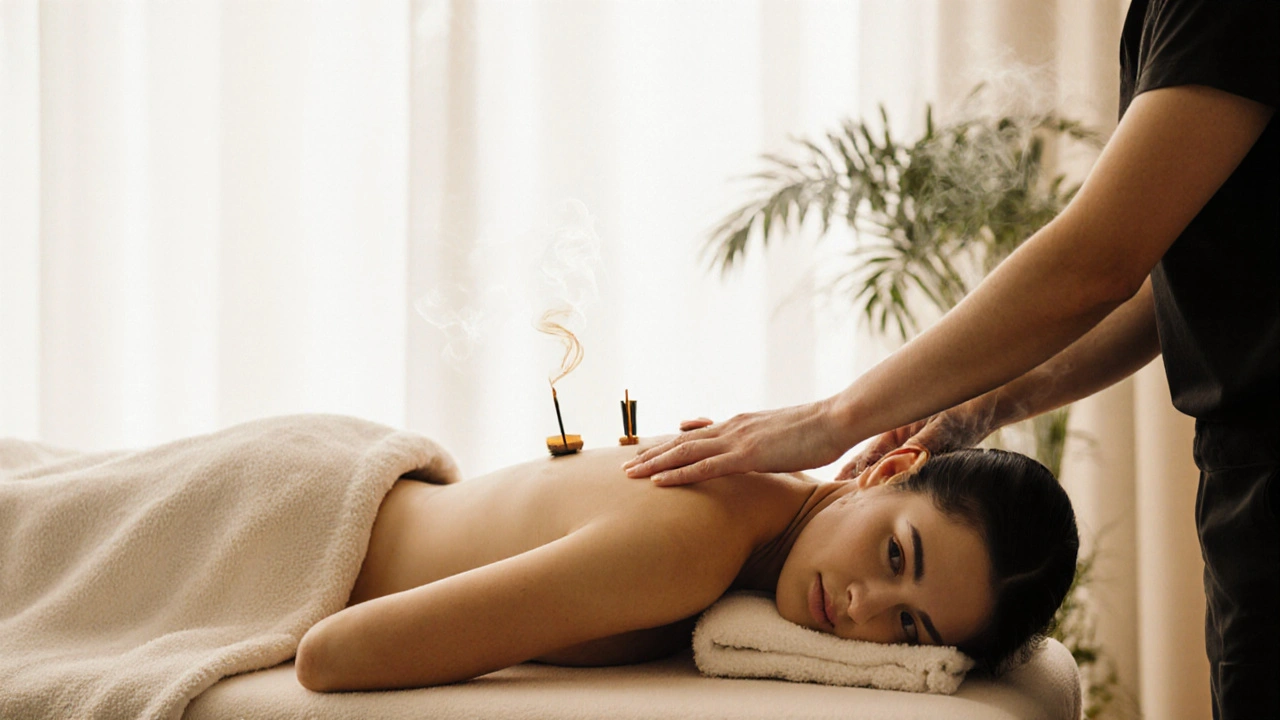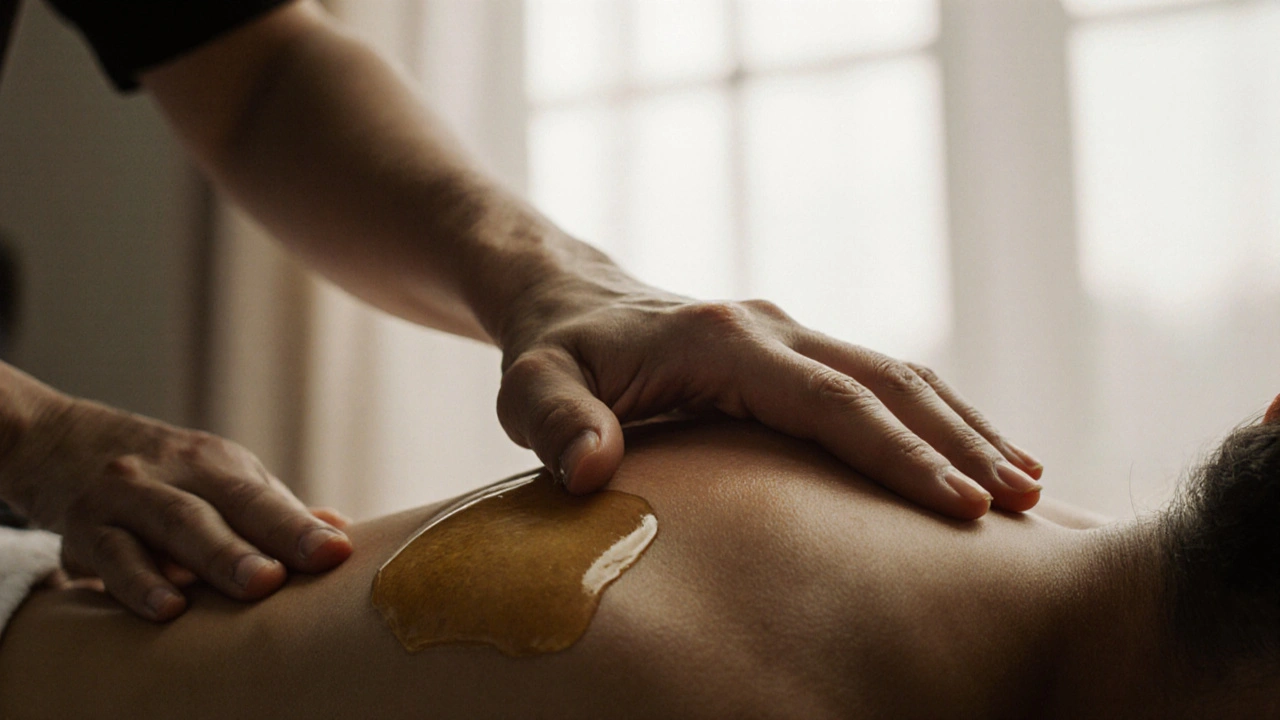Discover the Magic of Swedish Massage for Body Relaxation
 Nov, 15 2025
Nov, 15 2025
Massage Frequency Calculator
Personalized Massage Recommendation
Select your wellness goal to get your optimal Swedish massage frequency
Select your wellness goal to see personalized recommendations
Imagine sinking into a warm, quiet room. Soft music plays. Your muscles, tight from days of sitting at a desk or chasing kids around, start to melt under gentle, flowing strokes. That’s not fantasy-it’s a Swedish massage. And it’s one of the most effective, science-backed ways to reset your body and calm your mind.
What Makes Swedish Massage Different?
Not all massages are the same. Swedish massage isn’t about deep pressure or cracking joints. It’s built on five core techniques that work together like a gentle wave over your body: effleurage (long, gliding strokes), petrissage (kneading), friction (deep circular movements), tapotement (rhythmic tapping), and vibration (shaking or trembling motions). These aren’t random moves-they’re designed to increase blood flow, release muscle tension, and trigger your body’s natural relaxation response.
Unlike deep tissue massage, which targets chronic knots and adhesions, Swedish massage works on the surface layers of muscle and connective tissue. That makes it perfect for people who aren’t athletes or injury patients, but just feel worn down. Think of it as a full-body reset button.
Why Your Body Craves This Kind of Touch
Your nervous system doesn’t distinguish between stress from work, traffic, or sleepless nights. All of it triggers the same fight-or-flight response-your heart races, your shoulders tense, your breathing gets shallow. Swedish massage flips that switch. Studies from the Journal of Clinical Psychiatry show that just one 60-minute session lowers cortisol levels by an average of 31%. Cortisol is your body’s main stress hormone. When it drops, your body starts healing.
At the same time, serotonin and dopamine levels rise. These are your brain’s natural mood boosters. That’s why people often feel calm, even a little euphoric, after a Swedish massage. It’s not just relaxation-it’s neurochemical renewal.
How It Helps Beyond Just Feeling Good
People think of Swedish massage as a luxury. But its benefits are practical and measurable.
- Reduces muscle soreness: A 2023 study in Sports Medicine found that athletes who received weekly Swedish massages reported 30% less delayed onset muscle soreness (DOMS) after training.
- Improves sleep: The same study showed participants fell asleep 22 minutes faster and stayed asleep longer after consistent sessions.
- Lowers blood pressure: Regular Swedish massage has been linked to systolic blood pressure reductions of 8-10 mmHg-similar to the effect of light aerobic exercise.
- Boosts circulation: The gliding strokes help move lymph fluid, which carries away metabolic waste and reduces swelling in limbs.
If you’ve ever felt heavy or sluggish after a long day, it’s not just fatigue. It’s built-up tension and poor circulation. Swedish massage addresses both at once.

What to Expect in Your First Session
You don’t need to prepare much. Just avoid eating a heavy meal right before. Wear comfortable clothes, and know that you’ll be covered with a towel the whole time-only the area being worked on is exposed.
The therapist will start with light strokes to warm up your muscles. Then they’ll gradually increase pressure, always checking in with you. A good therapist doesn’t just follow a script-they adjust based on your breathing, muscle tension, and feedback. If something feels too firm, say so. This isn’t a test of endurance; it’s about comfort.
Most sessions last 60 to 90 minutes. You’ll leave feeling lighter, not drained. Some people feel a little lightheaded afterward-drink water, rest for 15 minutes, and you’ll be fine.
Who Should Try It (and Who Should Skip It)
Swedish massage is safe for almost everyone: office workers, parents, seniors, even pregnant women (with a trained prenatal therapist). It’s ideal if you:
- Feel constantly tense in your neck, shoulders, or back
- Struggle with stress or mild anxiety
- Sit for long hours
- Want to improve sleep without medication
It’s not for you if you have:
- Recent injuries, open wounds, or burns
- Severe osteoporosis or blood clotting disorders
- Active infections or fever
- Uncontrolled high blood pressure
If you’re unsure, talk to your doctor. Most therapists will ask for medical history before starting.
How Often Should You Get One?
There’s no magic number, but here’s what works for most people:
- For stress relief: Once a month keeps cortisol levels balanced.
- For chronic tension: Every two weeks for 6-8 weeks, then taper to monthly.
- For recovery: After intense physical activity, a session within 24-48 hours helps speed up recovery.
Think of it like brushing your teeth. You don’t wait until your gums bleed to do it. Same with massage-regular maintenance prevents bigger problems.

What to Look for in a Therapist
Not all massage therapists are trained the same. Look for someone certified by a recognized body like the Australian Association of Massage Therapists or equivalent in your country. Ask if they specialize in Swedish techniques-not just "relaxation massage," which can mean anything.
Read reviews that mention specific outcomes: "My shoulder pain disappeared," or "I slept through the night for the first time in months." That’s more useful than "great ambiance" or "nice oils."
Don’t be afraid to try a few different therapists. The right one feels like a good listener, not a technician.
Can You Do It at Home?
Self-massage tools like foam rollers or massage guns can help, but they can’t replace human touch. Why? Because the rhythm, pressure variation, and intuitive feedback from a trained therapist create a neurological response that machines can’t replicate.
That said, you can extend the benefits at home. After your session, take a warm bath, drink water, and avoid screens for an hour. Let your body stay in that calm state. Try gentle stretching-reach your arms overhead, roll your shoulders, bend side to side. It keeps the relaxation going.
The Real Magic Isn’t Just in the Hands
The true power of Swedish massage isn’t just the physical strokes. It’s the space it creates. In a world that never stops demanding more-more productivity, more connectivity, more speed-Swedish massage gives you permission to stop. To be still. To let your body feel safe again.
It’s not a cure-all. But for millions of people, it’s the one hour a week where everything else fades. And sometimes, that’s enough to change your whole week.
Is Swedish massage painful?
No, Swedish massage is not meant to be painful. It uses light to moderate pressure, and the goal is relaxation, not deep tissue work. If you feel pain, tell your therapist right away. A good session should feel soothing, not bruising.
How long does a Swedish massage last?
Most sessions last between 60 and 90 minutes. A 60-minute session covers the full body, while a 90-minute allows for more attention to areas like the back, neck, or legs. Shorter 30-minute sessions focus on specific areas, like shoulders or feet, but won’t give you the full experience.
Do I need to be naked during a Swedish massage?
No. You’ll be covered with a towel at all times. Only the part being massaged is exposed, and therapists are trained to maintain your privacy. Most people wear underwear or swimwear underneath the towel. Your comfort comes first.
Can Swedish massage help with anxiety?
Yes. Multiple studies show that Swedish massage reduces cortisol, the stress hormone, and increases serotonin and dopamine, which improve mood. Many people report feeling calmer, clearer-headed, and less reactive after regular sessions. It’s not a replacement for therapy, but it’s a powerful tool for managing daily anxiety.
Is Swedish massage safe during pregnancy?
Yes, when performed by a therapist trained in prenatal massage. Special positioning and gentle techniques are used to support the changing body. Many pregnant women find it helps with back pain, swelling, and sleep. Always inform your therapist you’re pregnant before the session begins.
What should I do after a Swedish massage?
Drink plenty of water to help flush out toxins released during the massage. Avoid caffeine, alcohol, or heavy meals right after. Take it easy for the rest of the day-go for a walk, sit quietly, or nap. Your body is still processing the relaxation response.
